
I have an article about what grain spawn is, what grain it is grown on, and why we use it in oyster mushroom production. Read here.
Table of Contents:
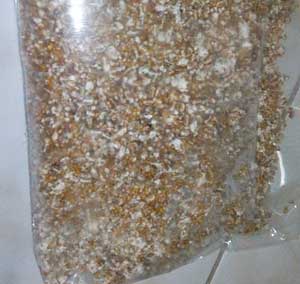 There is a photo of such a high-quality spawn below, in the section “How to choose a spawn supplier” ↓
There is a photo of such a high-quality spawn below, in the section “How to choose a spawn supplier” ↓
If you see loose grains in the bag and a yellow-brown color of the grain itself, it means that the spawn is not ripe enough. It is better not to buy such packages.
But if this happens and you bought an unripe spawn, put it in a warm, clean place (in no case in an incubator).
At a temperature of 18-22 degrees Celsius, the active mycelium will overgrow and become completely white in literally three to four days.
If during these three days it becomes covered with mold, this means that the infection occurred before delivery, and there is no way you could have infected it.
When can grain spawn become solid?
In this case, it can be broken and kneaded with great difficulty. It often also contains large blobs - saucers of rusty or light brown liquid underneath the film.
This means that the spawn was made two to three months ago and was in the refrigerator - either at your place or at the supplier's.
How do you know if mycelium is bad?
Gelatinous spots of yellow-brown color, mold of pink or all shades of green or black on the grains indicate that the spawn was made or stored in a non-sterile environment.
As a rule, in such cases, the entire package is contaminated with mold, and not just the part where its spores are visible.
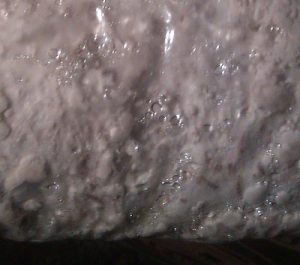
Even if you remove moldy areas of grain, you cannot be sure that mold hyphae have not grown into areas where spores are not yet visible.
After all, mold mycelium differs little in appearance from oyster mushroom mycelium; it is whitish or light gray.
And only spores have bright multi-colored colors.
Small black dots on the oyster mushroom spawn are also mold spores. If they are on thin hairs, this is one of the types of mucoraceae.
If the mycelium is contaminated with bacterial spores, wet spots of yellow or light brown color with an unpleasant odor will most likely form in the bag. These spots will be cloudy, not transparent.
Contaminated grain spawn cannot be inoculated.
Read more about mold in mushroom blocks.
If you come across such a lump, do not try to crush it in a container with previously mashed grains prepared for inoculation. Mold is often found in the middle of such conglomerates. Place such a lump in a plastic bag.
The remainder of the grain from this bag can be used for inoculation if it has a normal smell and the grains are uniformly white. Be sure to label the bags seeded from this briquette and watch their development.
As a rule, such mushroom blocks overgrow and bear fruit without any problems.
When you finish inoculating, carefully cut the stuck together grain and look to see if there is a colored coating or fluff in the cavity. If there is, it's mold. It can be green or olive. Less common are orange or pink shades.
Take a photo of a cross-section of the lump with a colored formation and the barcode of this package, contact the supplier and tell him about the problem.
High-quality grain spawn has a very subtle, slightly sweet aroma - it reminds me of the smell of milk.
I read on the Internet that good mycelium smells like wild mushrooms. For me, wild mushrooms smell of freshness, even more like rain, but mycelium does not have such a smell.
Any strong smell - sour, “smelly”, alcohol, antibiotics or ammonia indicates that the development of the mycelium did not proceed correctly; such a smell indicates a defect.
Mushroom spawn storage temperature.
Storage should be in a refrigerator, separate from mushrooms, at a temperature of 0 to 2°C.
Does mycelium need light in the spawn bag, or is it better to keep it in the dark?
Mycelium does not need light.
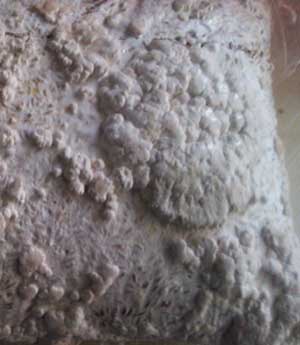
It's okay to turn on the lights when you go into the refrigerator, but don't leave them on when you're not there!
If the mycelium is left in the light for a long time, it can become active and begin to grow.
What happens if grain spawn is stored at temperatures above 2 degrees Celsius?
If the mycelium is fresh and active, at temperatures above 5 degrees it forms white compactions protruding above the grain surface.
This begins the germination of hyphae, primarily under the filters, where gases are exchanged, oxygen enters from the outside, and the formation of primordia begins.
See the picture on the left.
A short-term decrease (increase) of 2-3 degrees is acceptable.
You cannot freeze grain spawn!
If the mycelium is frozen (stored below minus 2-3°C for a long time), then when it is thawed (defrosted), it loses its activity.
The longer it was stored frozen, the higher the likelihood of not only loss of activity, but also its partial death. Blocks inoculated with it become overgrown, but do not produce a crop.
It happens that after defrosting it not only overgrows well, but also produces a harvest. But why take the risk?
The documentation must indicate the final period of use, after which the supplier is not responsible for its quality.
Shelf life depends on storage conditions.
Some heat-loving varieties cannot be stored in the refrigerator.
Initially, it is advisable to draw up a delivery schedule in order to use only fresh material. However, if you live far from the supplier and have to purchase a large batch for a long time, you need a separate cold storage for storing spawn.
As a general rule, it is believed that grain spawn should be used within 10-12 weeks of production.
You can store it in your refrigerator for longer than this period unless the mycelium begins to grow in the spawn bag.
The shelf life of mushroom spawn of golden and pink oyster mushrooms is less - 2-3 weeks at temperatures from +8 to +10 degrees Celsius.
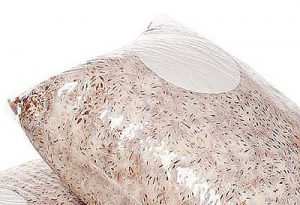
Ask the manufacturer the following questions:
- Does the supplier provide a technological passport for growing strains?
- from which laboratory did the supplier source the source (mother culture) of the variety? Find this laboratory on the Internet. If there is no information about it, think about whether you should trust it.
- Does the supplier keep records of products sold, is there any identification mark, barcode or batch number on the packages.
The use of a barcode indicates that the manufacturer takes its products seriously. This indicates the uniqueness of each package - it is easy to track. Labeling can only be developed for product registration purposes. That is, it does not contain information about the country of production, but only about the batch of goods and the name of the strain. If you buy packages with a barcode, ask the manager what information it contains.
- Are there filters on cellophane? Filters can be round and similar to cotton pads (as in the photo next) or in the form of a tape with notches (as in the photo below).
- Is the package sealed?
If it is simply tied or sealed with tape, if there are no filters through which the oyster mushroom mycelium breathes, it is better not to risk it.
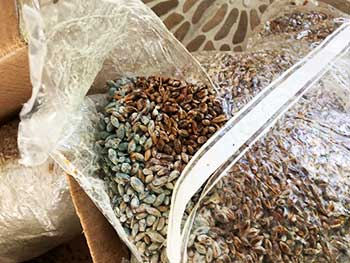
He's definitely spoiled!
The defect could appear both at the company that produces it and at your place. If mold develops near a tear (cut, puncture) of cellophane, it has penetrated into the contents through this hole as a result of improper storage.
When receiving the shipment, carefully inspect each package, as they could have been damaged during transportation. If you find a tear, seal it with tape immediately.
Inoculate it immediately (do not store) and do not mix it with others in the same bowl. You must sign these blocks. If these blocks are poorly overgrown, have green mold or smell bad, it means that contaminant spores have already penetrated through the tear.
If packages are delivered with visible orange, pink, black, green stains, take photographs of them, contact the supplier and demand compensation.
What to do if the packaging is torn?
If it breaks in your hands - it gets caught on the corner of the box, or falls and tears, seal the tear with tape and inoculate it immediately.
If you find torn packaging in the delivered batch, immediately contact the manufacturer and send a photo. Such holes can be sealed and used.
Be sure to label the blocks that were inoculated from these torn packs.
If there is green mold in the spawn bag, throw it away without regret.
Otherwise, you will spoil the steamed raw materials and infect the incubator with mold spores. Do you need it?
Many mushroom growers believe that the quality of oyster mushroom mycelium can be compared in this way: inoculate spawn from two different companies into the same substrate.
It is assumed that if the substrate is of the same quality, and one of the strains overgrows poorly or has a lower yield, this means that this particular spawn is of lower quality.
I don’t know if there is such a misconception in your country, but such a comparison is not correct.
 Your substrate may not be of ideal quality, which will result in differences in germination between different strains from different suppliers.
Your substrate may not be of ideal quality, which will result in differences in germination between different strains from different suppliers.
Some of the strains may be more aggressive in capturing the substrate, but after growth, do not give primordium for a long time.
Or your microclimate will be suitable for one strain, but unfavorable for another.
For example:
- When pasteurizing raw materials with hot water, the bottom layer of the substrate may become waterlogged.
When steam pasteurizing in a tunnel, the wetter layers are often the side layers and/or the top layer if the insulation of the tunnel roof is insufficient.
In a waterlogged substrate there is free water, which during incubation collects in the layer between the film and the substrate. Microorganisms (mold or bacteria) will begin to multiply in this layer and there will be a lot of yellow wet spots or green mold in the bag.
That is, blocks made from bottom and side layers will not overgrow well. And in the substrate from the center, the mycelium grows well and gives a good harvest.
And if those blocks are inoculated with another supplier's grain spawn, you'll blame them, not your technology.
- The same situation may arise if the top bags are not completely covered with water during heat treatment of raw materials. Then part of the substrate that has undergone insufficient heat treatment may deteriorate.
These blocks will begin to rot, and you will decide that the spawn is to blame.
And your argument will be that spawn from another manufacturer is overgrown without damage.
And it won’t be a matter of spawn at all, but a difference in the properties of your substrate, even though it was processed in the same container.
The mycelium in grain can indeed be old, overpacked and of poor quality. Read my article about this.
If you are confident in the quality of your processing method, a correct comparison would be:
Remember, no matter how much you want to blame the spawn suppliers for your troubles:
If the block is overgrown well, the primordia appeared on time and were beautiful at the very beginning of development, then everything that happens after is your own shortcomings in making the substrate, or shortcomings in the microclimate during incubation and in the growing room. And most often, unfortunately, it’s both.
Read more about this here.
